Thursday, June 09, 2016
More fun with tubes
Experimenting with the Mystery Tube inspired me to dig further into submini tubes. I'd skipped tubes in my previous electronics playing. Big tubes require way too much overhead. Multi-winding transformers and rectifiers; sheetmetal work to hold the sockets; worst of all, the whole setup, including the experimenter, needs to be ready to handle 250V. Amid all that expense and danger there's not much room for piddling around.
These subminis are no worse than transistors in terms of overhead, and far more interesting than transistors.
I ordered a bunch of hearing aid tubes through Ebay, type 6418 pentodes.
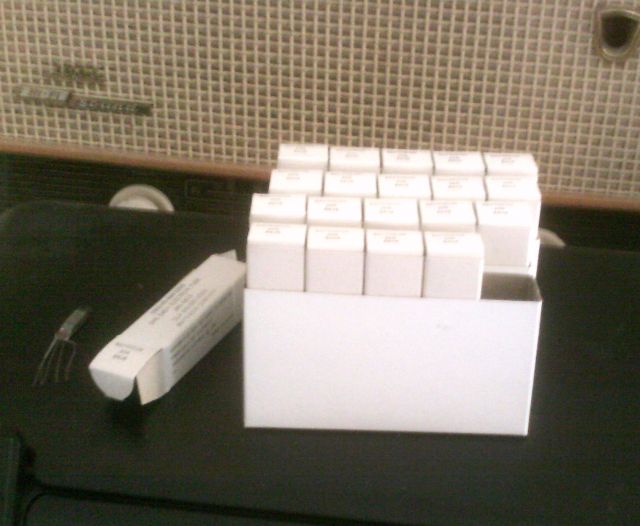 The 5-packs seem to have been assembled by a previous big retailer in 1985, who also added a UPC code to the tube boxes.
The 5-packs seem to have been assembled by a previous big retailer in 1985, who also added a UPC code to the tube boxes.
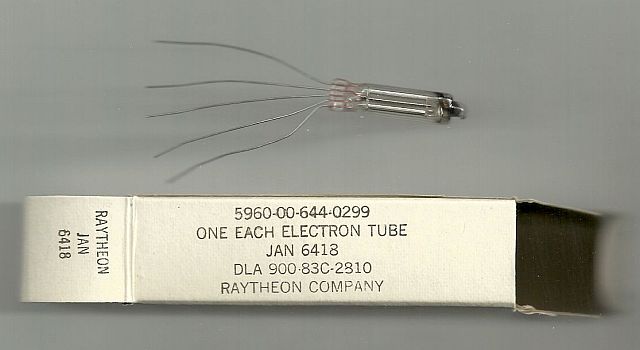 Here's one tube along with its original milspec box. The code starting with 5960 is the military part number. Looking it up, this particular number is no longer used, but there are still a LOT of active 5960 (tube) numbers. Smart military, holding onto EMP-immune technology as long as possible. Not nearly as smart as Russia, but that doesn't need saying. [Sidenote: WW2-era milspec tube boxes said TUBE, ELECTRON, ONE instead of ONE EACH ELECTRON TUBE. Old way was funnier.]
Here's one tube along with its original milspec box. The code starting with 5960 is the military part number. Looking it up, this particular number is no longer used, but there are still a LOT of active 5960 (tube) numbers. Smart military, holding onto EMP-immune technology as long as possible. Not nearly as smart as Russia, but that doesn't need saying. [Sidenote: WW2-era milspec tube boxes said TUBE, ELECTRON, ONE instead of ONE EACH ELECTRON TUBE. Old way was funnier.]
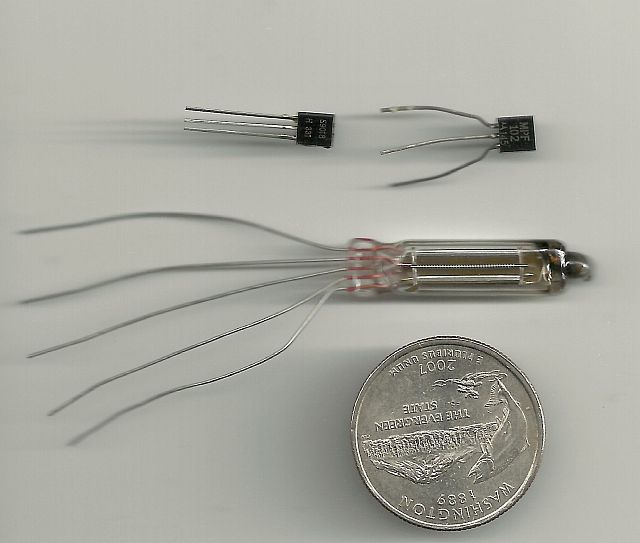 Tube along with the two transistors that would be needed to replace it. Some applications would need three.
Sidenote: When these tubes were used in hearing aids, the wires were soldered to a little inline 5-pin plug, which was inserted in a socket on the chassis. Made replacement easier. I thought this was how the tubes were sold, but after looking at a lot of them on Ebay, I'm only seeing raw wires. Puzzling. Maybe hearing aid companies like Zenith added the sockets so the hearing aid salesman could replace tubes easily.
The Ebay price was $14 for 20 tubes in NOS condition. 70 cents each! Outstanding bargain. 20 tubes should allow for some bad units, give me a chance to burn up a few.
In general Ebay tube prices are well below what specialist 'antique electronics' dealers charged 10 years ago. Tubes prized by audiophiles (such as matched Mullard long-plate ECC83s) run into the hundreds, but most are close to their original price in nominal dollars, not inflated dollars.
I'm guessing this tube was made in the late '50s. A few common tubes were around a dollar in 1959, but most were around $3.00 retail, and this submini is in the typical range. A page from an Allied catalog in 1959 includes the 6418 (circled):
Tube along with the two transistors that would be needed to replace it. Some applications would need three.
Sidenote: When these tubes were used in hearing aids, the wires were soldered to a little inline 5-pin plug, which was inserted in a socket on the chassis. Made replacement easier. I thought this was how the tubes were sold, but after looking at a lot of them on Ebay, I'm only seeing raw wires. Puzzling. Maybe hearing aid companies like Zenith added the sockets so the hearing aid salesman could replace tubes easily.
The Ebay price was $14 for 20 tubes in NOS condition. 70 cents each! Outstanding bargain. 20 tubes should allow for some bad units, give me a chance to burn up a few.
In general Ebay tube prices are well below what specialist 'antique electronics' dealers charged 10 years ago. Tubes prized by audiophiles (such as matched Mullard long-plate ECC83s) run into the hundreds, but most are close to their original price in nominal dollars, not inflated dollars.
I'm guessing this tube was made in the late '50s. A few common tubes were around a dollar in 1959, but most were around $3.00 retail, and this submini is in the typical range. A page from an Allied catalog in 1959 includes the 6418 (circled):
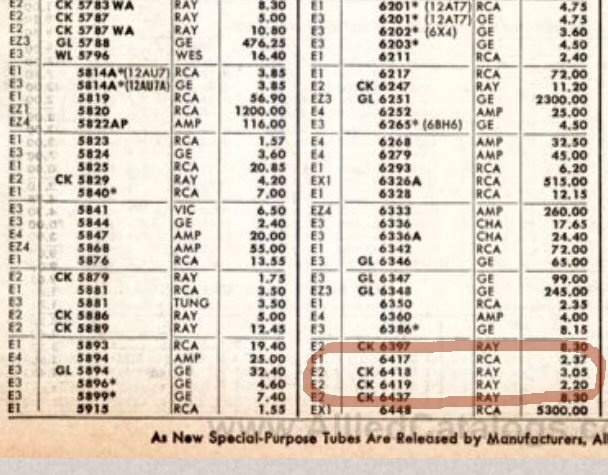 $3.05 would be $25 now by plain inflation.
Incidentally, the tube at the bottom of the page, priced at $5300!! ($44k today) was a high-power water-cooled UHF Klystron transmitting tube. It probably would have been used by a military radar installation, and wouldn't have been bought through Allied.
= = = = =
Starting to play around. Hooked up 1.5v to filament. It lights! Yay! The light and heat are delicate compared to a larger tube; this isn't going to emit tube glow or tube smell. Even with all the room lights off, it's just barely visible, and just barely warm.
$3.05 would be $25 now by plain inflation.
Incidentally, the tube at the bottom of the page, priced at $5300!! ($44k today) was a high-power water-cooled UHF Klystron transmitting tube. It probably would have been used by a military radar installation, and wouldn't have been bought through Allied.
= = = = =
Starting to play around. Hooked up 1.5v to filament. It lights! Yay! The light and heat are delicate compared to a larger tube; this isn't going to emit tube glow or tube smell. Even with all the room lights off, it's just barely visible, and just barely warm.
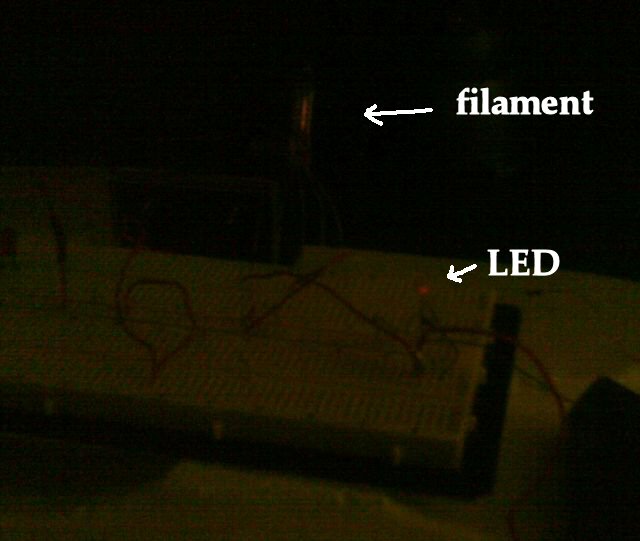 Tried using a rechargeable weedwhacker battery for 20V plate. Because the big batt has nearly unlimited 'push', it turned out to be almost as dangerous as the AC mains. I had to use clip leads to connect to it. When both clip leads accidentally touched the aluminum foil surface of my workdesk, BZZZT! Arc welding! Big noise, big spark, hole in the foil, smoke in the wood.
Tried using a rechargeable weedwhacker battery for 20V plate. Because the big batt has nearly unlimited 'push', it turned out to be almost as dangerous as the AC mains. I had to use clip leads to connect to it. When both clip leads accidentally touched the aluminum foil surface of my workdesk, BZZZT! Arc welding! Big noise, big spark, hole in the foil, smoke in the wood.
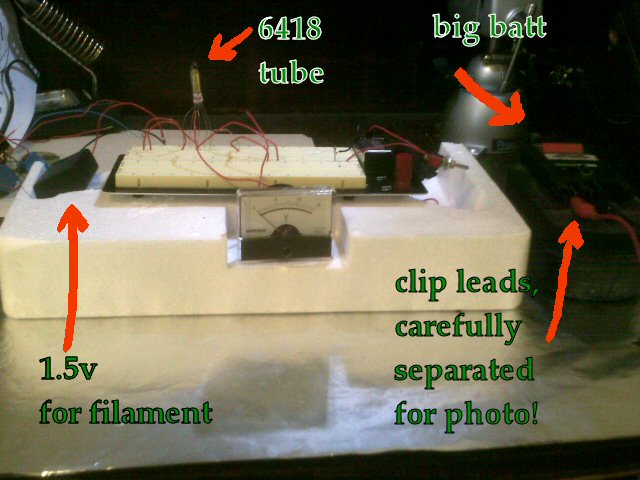 Decided to fall back to tame 9V batt, already part of my breadboard setup. The tube's data sheet claims that the tube should still amplify with 9V, though it's near the low end of working range.
= = = = =
Next day: Yay! Amplifier action! Contrary to the data sheet, 9V wasn't enough. Had to put two nines in series to get a tame 18V plate supply. With the extra pull, a simple ckt worked just the way it should. Here's the ckt, scrawled and scanned:
Decided to fall back to tame 9V batt, already part of my breadboard setup. The tube's data sheet claims that the tube should still amplify with 9V, though it's near the low end of working range.
= = = = =
Next day: Yay! Amplifier action! Contrary to the data sheet, 9V wasn't enough. Had to put two nines in series to get a tame 18V plate supply. With the extra pull, a simple ckt worked just the way it should. Here's the ckt, scrawled and scanned:
 The voltmeter is across the plate resistor, so a higher reading means more flow through the cathode and plate. Screen grid is tied to plus through the same size R. Suppressor grid is internally tied to filament. The control grid is highly sensitive; touching with fingers changes the flow, and 'bridging' to other wires with fingers makes more flow.
Short clip showing the action:
Now that I've got my literal hands on the basic requirements, I can move on to more interesting stuff. More later.......
The voltmeter is across the plate resistor, so a higher reading means more flow through the cathode and plate. Screen grid is tied to plus through the same size R. Suppressor grid is internally tied to filament. The control grid is highly sensitive; touching with fingers changes the flow, and 'bridging' to other wires with fingers makes more flow.
Short clip showing the action:
Now that I've got my literal hands on the basic requirements, I can move on to more interesting stuff. More later.......
 The 5-packs seem to have been assembled by a previous big retailer in 1985, who also added a UPC code to the tube boxes.
The 5-packs seem to have been assembled by a previous big retailer in 1985, who also added a UPC code to the tube boxes.
 Here's one tube along with its original milspec box. The code starting with 5960 is the military part number. Looking it up, this particular number is no longer used, but there are still a LOT of active 5960 (tube) numbers. Smart military, holding onto EMP-immune technology as long as possible. Not nearly as smart as Russia, but that doesn't need saying. [Sidenote: WW2-era milspec tube boxes said TUBE, ELECTRON, ONE instead of ONE EACH ELECTRON TUBE. Old way was funnier.]
Here's one tube along with its original milspec box. The code starting with 5960 is the military part number. Looking it up, this particular number is no longer used, but there are still a LOT of active 5960 (tube) numbers. Smart military, holding onto EMP-immune technology as long as possible. Not nearly as smart as Russia, but that doesn't need saying. [Sidenote: WW2-era milspec tube boxes said TUBE, ELECTRON, ONE instead of ONE EACH ELECTRON TUBE. Old way was funnier.]
 Tube along with the two transistors that would be needed to replace it. Some applications would need three.
Sidenote: When these tubes were used in hearing aids, the wires were soldered to a little inline 5-pin plug, which was inserted in a socket on the chassis. Made replacement easier. I thought this was how the tubes were sold, but after looking at a lot of them on Ebay, I'm only seeing raw wires. Puzzling. Maybe hearing aid companies like Zenith added the sockets so the hearing aid salesman could replace tubes easily.
The Ebay price was $14 for 20 tubes in NOS condition. 70 cents each! Outstanding bargain. 20 tubes should allow for some bad units, give me a chance to burn up a few.
In general Ebay tube prices are well below what specialist 'antique electronics' dealers charged 10 years ago. Tubes prized by audiophiles (such as matched Mullard long-plate ECC83s) run into the hundreds, but most are close to their original price in nominal dollars, not inflated dollars.
I'm guessing this tube was made in the late '50s. A few common tubes were around a dollar in 1959, but most were around $3.00 retail, and this submini is in the typical range. A page from an Allied catalog in 1959 includes the 6418 (circled):
Tube along with the two transistors that would be needed to replace it. Some applications would need three.
Sidenote: When these tubes were used in hearing aids, the wires were soldered to a little inline 5-pin plug, which was inserted in a socket on the chassis. Made replacement easier. I thought this was how the tubes were sold, but after looking at a lot of them on Ebay, I'm only seeing raw wires. Puzzling. Maybe hearing aid companies like Zenith added the sockets so the hearing aid salesman could replace tubes easily.
The Ebay price was $14 for 20 tubes in NOS condition. 70 cents each! Outstanding bargain. 20 tubes should allow for some bad units, give me a chance to burn up a few.
In general Ebay tube prices are well below what specialist 'antique electronics' dealers charged 10 years ago. Tubes prized by audiophiles (such as matched Mullard long-plate ECC83s) run into the hundreds, but most are close to their original price in nominal dollars, not inflated dollars.
I'm guessing this tube was made in the late '50s. A few common tubes were around a dollar in 1959, but most were around $3.00 retail, and this submini is in the typical range. A page from an Allied catalog in 1959 includes the 6418 (circled):
 $3.05 would be $25 now by plain inflation.
Incidentally, the tube at the bottom of the page, priced at $5300!! ($44k today) was a high-power water-cooled UHF Klystron transmitting tube. It probably would have been used by a military radar installation, and wouldn't have been bought through Allied.
= = = = =
Starting to play around. Hooked up 1.5v to filament. It lights! Yay! The light and heat are delicate compared to a larger tube; this isn't going to emit tube glow or tube smell. Even with all the room lights off, it's just barely visible, and just barely warm.
$3.05 would be $25 now by plain inflation.
Incidentally, the tube at the bottom of the page, priced at $5300!! ($44k today) was a high-power water-cooled UHF Klystron transmitting tube. It probably would have been used by a military radar installation, and wouldn't have been bought through Allied.
= = = = =
Starting to play around. Hooked up 1.5v to filament. It lights! Yay! The light and heat are delicate compared to a larger tube; this isn't going to emit tube glow or tube smell. Even with all the room lights off, it's just barely visible, and just barely warm.
 Tried using a rechargeable weedwhacker battery for 20V plate. Because the big batt has nearly unlimited 'push', it turned out to be almost as dangerous as the AC mains. I had to use clip leads to connect to it. When both clip leads accidentally touched the aluminum foil surface of my workdesk, BZZZT! Arc welding! Big noise, big spark, hole in the foil, smoke in the wood.
Tried using a rechargeable weedwhacker battery for 20V plate. Because the big batt has nearly unlimited 'push', it turned out to be almost as dangerous as the AC mains. I had to use clip leads to connect to it. When both clip leads accidentally touched the aluminum foil surface of my workdesk, BZZZT! Arc welding! Big noise, big spark, hole in the foil, smoke in the wood.
 Decided to fall back to tame 9V batt, already part of my breadboard setup. The tube's data sheet claims that the tube should still amplify with 9V, though it's near the low end of working range.
= = = = =
Next day: Yay! Amplifier action! Contrary to the data sheet, 9V wasn't enough. Had to put two nines in series to get a tame 18V plate supply. With the extra pull, a simple ckt worked just the way it should. Here's the ckt, scrawled and scanned:
Decided to fall back to tame 9V batt, already part of my breadboard setup. The tube's data sheet claims that the tube should still amplify with 9V, though it's near the low end of working range.
= = = = =
Next day: Yay! Amplifier action! Contrary to the data sheet, 9V wasn't enough. Had to put two nines in series to get a tame 18V plate supply. With the extra pull, a simple ckt worked just the way it should. Here's the ckt, scrawled and scanned:
 The voltmeter is across the plate resistor, so a higher reading means more flow through the cathode and plate. Screen grid is tied to plus through the same size R. Suppressor grid is internally tied to filament. The control grid is highly sensitive; touching with fingers changes the flow, and 'bridging' to other wires with fingers makes more flow.
Short clip showing the action:
Now that I've got my literal hands on the basic requirements, I can move on to more interesting stuff. More later.......
The voltmeter is across the plate resistor, so a higher reading means more flow through the cathode and plate. Screen grid is tied to plus through the same size R. Suppressor grid is internally tied to filament. The control grid is highly sensitive; touching with fingers changes the flow, and 'bridging' to other wires with fingers makes more flow.
Short clip showing the action:
Now that I've got my literal hands on the basic requirements, I can move on to more interesting stuff. More later.......
Labels: defensible thymes, new toy, skill-estate, Zero Problems
